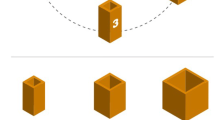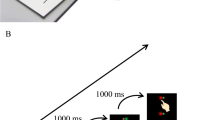Abstract
Nine young infants were followed longitudinally from 4 to 15 months of age. We recorded early spontaneous movements and reaching movements to a stationary target. Time-position data of the hand (endpoint), shoulder, and elbow were collected using an optoelectronic measurement system (ELITE). We analyzed the endpoint kinematics and the intersegmental dynamics of the shoulder and elbow joint to investigate how changes in proximal torque control determined the development of hand trajectory formation. Two developmental phases of hand trajectory formation were identified: a first phase of rapid improvements between 16 and 24 weeks of age, the time of reaching onset for all infants. During that time period the number of movement units per reach and movement time decreased dramatically. In a second phase (28–64 weeks), a period of “fine-tuning” of the sensorimotor system, we saw slower, more gradual changes in the endpoint kinematics. The analysis of the underlying intersegmental joint torques revealed the following results: first, the range of muscular and motiondependent torques (relative to body weight) did not change significantly with age. That is, early reaching was not confined by limitations in producing task-adequate levels of muscular torque. Second, improvements in the endpoint kinematics were not accomplished by minimizing amplitude of muscle and reactive torques. Third, the relative timing of muscular and motion-dependent torque peaks showed a systematic development toward an adult timing profile with increasing age. In conclusion, the development toward invariant characteristics of the hand trajectory is mirrored by concurrent changes in the control of joint forces. The acquisition of stable patterns of intersegmental coordination is not achieved by simply regulating force amplitude, but more so by modulating the correct timing of joint force production and by the system's use of reactive forces. Our findings support the view that development of reaching is a process of unsupervised learning with no external or innate teacher prescribing the desired kinematics or kinetics of the movement.
Similar content being viewed by others
References
Abend W, Bizzi E, Morasso P (1982) Human arm trajectory formation. Brain 105: 331–348
Atkeson CG (1989) Learning arm kinematics and dynamics. Ann Rev Neurosci 12: 157–183
Bernstein N (1967) The co-cordination and regulation of movements. Pergamon, Oxford
Bizzi E (1993) Intermediate representations in the formation of arm trajectories. Curr Opin Neurobiol 3: 925–931
Brody BA, Kinney HC, Kloman AS, Gilles FH (1987) Sequence of central nervous system myelination in human infancy. I. An autopsy study of myelination. J Neuropathol Exp Neurol 46(3): 283–301
Brooks VB, Cooke JC, Thomas JS (1973) The continuity of movements. In: Stein RB, Pearson KG, Smith RS, Bedford JB (eds) Control of posture and locomotion. Plenum, New York, pp 257–272
D'Amico M, Ferrigno G (1992) Comparison between the more recent techniques for smoothing and derivative assessment in biomechanics. Med Biol Eng Comp 30: 193–204
Dobbing J, Sands J (1973) Quantitative growth and development of human brain. Arch Dis Child 48: 757–767
Fetters L, Todd J (1987) Quantitative assessment of infant reaching movements. J Mot Behav 19 (2): 147–166
Georgopoulos AP, Kalaska JF, Massey JT (1981) Spatial trajectories and reaction times of aimed movements: effects of practice, uncertainty, and change in target location. J Neurophysiol 46(4): 725–743
Gordon J, Ghilardi MF, Ghez C (1994) Accuracy of planar reaching movements. I. Independence of direction and extent variability. Exp Brain Res 99(1): 97–111
Hofsten C von (1979) Development of visually directed reaching: the approach phase. J Hum Mov Stud 5: 160–178
Hofsten C von (1991) Structuring of early reaching movements: a longitudinal study. J Mot Behav 23(4): 280–292
Hong D-A, Corcos DM, Gottlieb GL (1994) Task dependent patterns of muscle activation at the shoulder and elbow for unconstrained arm movements. J Neurophysiol 71(3): 1261–1264
Kalveram KT (1992) A neural network model rapidly learning gains and gating of reflexes necessary to adapt to an arm's dynamics. Biol Cybern 68: 183–191
Konczak J, Thelen E (1994) The dynamics of goal-directed reaching: a comparison of adult and infant movement patterns. In: Van Rossum JHA, Laszlo JL (eds) Motor development: aspects of normal and delayed development. VU University Press, Amsterdam, pp 25–40
Kreighbaum, B, Barthels KM (1990) Biomechanics. Macmillan, New York
Kuperstein M (1991) INFANT neural controller for adaptive sensory-motor coordination. Neural Networks 4: 131–145
Mathew A, Cook M (1986) The control of reaching movements by young infants. Child Dev 61: 1238–1257
Morasso P (1981) Spatial control of arm movements. Exp Brain Res 42: 223–227
Morasso P (1983) Three dimensional arm trajectories. Biol Cybern 48: 187–194
Schneider K, Zernicke RA (1990) A fortran package for the planar analysis of limb intersegmental dynamics from spatial coordinate-time data. Adv Eng Software 12(3): 123–127
Schneider K, Zernicke RF (1992) Mass, center of mass, and moment of inertia estimates for infant limb segments. J Biomech 25: 145–148
Soechting JF, Terzuolo CA (1990) Sensorimotor transformations and the kinematics of arm movements in three-dimensional space. In: Jeannerod M (ed) Motor representation and control (Attention and Performance XIII). Erlbaum, Hillsdale, NJ, pp 479–494
Thelen E, Zernicke R, Schneider K, Jensen J, Kamm K, Corbetta (1992) The role of intersegmental dynamics in infant neuromotor development. In: Stelmach GE, Requin J (eds) Tutorials in motor behavior II. Elsevier, Amsterdam, pp 533–548
Thelen E, Corbetta D, Kamm K, Spencer JP, Schneider K, Zernicke RF (1993) The transition to reaching: mapping intention and intrinsic dynamics. Child Dev 64: 1058–1098
Author information
Authors and Affiliations
Rights and permissions
About this article
Cite this article
Konczak, J., Borutta, M., Topka, H. et al. The development of goal-directed reaching in infants: hand trajectory formation and joint torque control. Exp Brain Res 106, 156–168 (1995). https://doi.org/10.1007/BF00241365
Received:
Accepted:
Issue Date:
DOI: https://doi.org/10.1007/BF00241365




